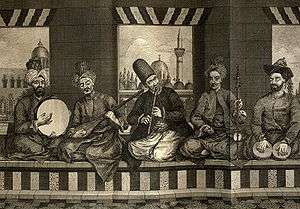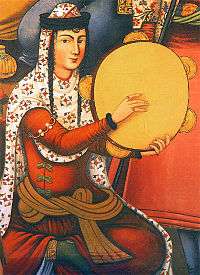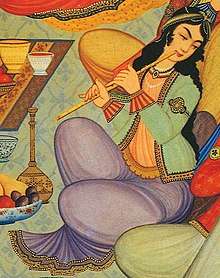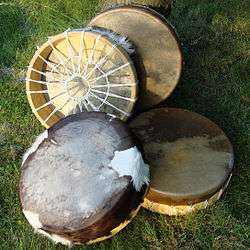Daf
The daf (Persian: دف, romanized: daf; Kurdish: def ,دەف;[1][2]), is a large Kurdish[3] and Persian[4] frame drum used in popular and classical music. Moreover, is it also used in religious ceremonies among Kurds.[5] The Daf is also considered as the national musical instrument of Pakistan.[6]
 | |
| Percussion instrument | |
|---|---|
| Other names | dafli, dap, def, tef, defi, gaval, duf, duff, dof |
| Classification | Directly struck membranophones |
| Hornbostel–Sachs classification | 211.311 (Handle-less frame drum with one usable membrane) |
| Playing range | |
| High sound of jingles, plus some have a skin with a lower sound. | |
| Related instruments | |
| Riq, Buben, Dayereh, Tambourine, Kanjira, Frame drum | |


History
The instrument is depicted in mesolithic cave painting at Lakha Juar, Bhimbhetka[7] and in Assyrian Empire relief. The Pahlavi (an ancient Iranian language) name of the daf is dap. Some pictures of dap have been found in paintings that date before the Common Era. The presence of Iranian dap in the reliefs of Behistun suggests the daf existed before the rise of Islam. Shunga art and Mathura art carved panels around 2nd BCE - 2nd CE, also show ancient Indians playing this instrument by beating it with metal or wooden sticks like dholak or simply using their hands.[8] Dafs were part of religious music in Iran much before Sufism. Iranian music has always been a spiritual tool. It shows that dafs played an important role in Mazdean Iran emerging as an important element during the Sassanian times during the Kâvusakân dynasty. Also, there is a kind of square frame drum in the stonecutting of Taq-e Bostan (another famous monument located 5 km (3 mi) northeast of Kermanshah city). These frame drums were played in the ancient Middle East (chiefly by women in Kurdish societies), Greece, and Rome and reached medieval Europe through Islamic culture.
Nowruz (the first day of the Iranian New Year and the national festival of the Iranian peoples) and other festive occasions have been accompanied by dap in Sassanid periods (224 A.D. - 651 A.D.). In this period the dap was played in order to accompany Iranian classical music. Daps were likely used in the court to be played in the modes and melodies of traditional music. This traditional or classical music was created by Barbod the Great and was named the khosravani after the mythical king Khosrow. Recent research reveals that these modes were used in the recitation of Mazdean (Zoroastrian) prayers. The modes were passed down from master to student and are today known as the radif and dastgah system. Many of the melodies were lost, but most of those that remain date to the Sassanid period. Dafs can be played to produce highly complex and intense rhythms, causing one to go under a trance and reach an ecstatic and spiritually-high state. For this reason, they have always been connected with religion in Iran.
The Arabs introduced the daf and other Middle Eastern musical instruments to Spain, and the Spanish adapted and promoted the daf and other musical instruments (such as the guitar) in medieval Europe. In the 15th century, the daf was only used in Sufi ceremonies; the Ottomans reintroduced it to Europe in the 17th century.
The art of daf playing in Iranian Kurdistan and other parts of Iran has reached us by the effort of Iranian Sufis; especially in the 20th century. The daf still functions as an important part of Persian art music (traditional or classical music) as it did in ancient times. It successfully encourages many young Iranians to take up learning this ancient instrument.
Defi
The defi (sometimes called daire in other areas) is a fairly large frame drum with metal bangles. Similar to a tambourine in construction, the defi is made with a metal screw system so that the head can be tightened and tuned. It is popular in many forms all over Greece, especially in the mainland klarino music. The defi is particularly popular in the Epirus region of northwestern Greece, where they are still handmade today. They have a low tone, and the bangles are low pitched as well.
Cultural references
In the history of Iran, daf had important usage specially in celebrations. It was the only musical instrument permitted by the Islamic prophet Muhammad to play during celebrations.[9]
A daf is depicted on the reverse of the Azerbaijani 1 qəpik coin minted since 2006[10] and on the obverse of the Azerbaijani 1 manat banknote issued since 2006.[11]
References
- Tony Langlois (2017). Non-Western Popular Music. Routledge. p. 91. ISBN 978-1351556156.
- "سارا تهڵایی: دەف بە شێوەیەی ئێستای موڵکی هیچ و وڵاتێک نییە و تایبەتە بە کورد" (in Kurdish). Basnews. Retrieved 18 March 2020.
- Anders Hammarlund; Tord Olsson; Elisabeth Ozdalga (2004). Sufism, Music and Society in Turkey and the Middle East. Routledge. p. 139. ISBN 9781135796761.
- Emami, Seyede Faranak (2014). "Acoustic Sensitivity of the Saccule and Daf Music". Iranian Journal of Otorhinolaryngology. 26 (75): 105–110. ISSN 2251-7251. PMC 3989875. PMID 24744999.
- "Daf(f) and Dayera". Iranica Online. Retrieved 24 March 2020.
- "Instruments of Pakistan". American Institute of Pakistani Studies.
|first=missing|last=(help) - Varadpande, Manohar Laxman (1987). History of Indian Theatre. Abhinav Publications. pp. 55, illustration no 10. ISBN 9788170172215.
- "Government Museum Mathura - Picture of Government Museum Mathura, Mathura - TripAdvisor". www.tripadvisor.co.za. Retrieved 2019-04-17.
- al-Munajjid, Muhammad Salih. "When is it permissible to beat the daff? - Islam Question & Answer". Islam Question & Answer. IslamQA. Retrieved 27 August 2019.
- Central Bank of Azerbaijan. National currency: New generation coins. – Retrieved on 25 February 2010.
- National Bank of Azerbaijan Archived 2009-04-14 at the Wayback Machine. National currency: 1 manat. – Retrieved on 25 March 2009. (Old site -now a dead link- that mentioned the instrument as a daf).
Central Bank of Azerbaijan. National currency: 1 manat. – Retrieved on 25 February 2010. (Current site that mentions the instrument as a drum).
External links
- Nasehpour, Peyman (2015). "On Persian Daf, the Spiritual Frame Drum and Sufi Music". Nasehpour.com. Peyman Nasehpour.
- World Records India, Paavan (2019). "Most People Dance with Hand Drum (Dafli)". worldrecordsindia.com. World Records of India.


.jpg)

